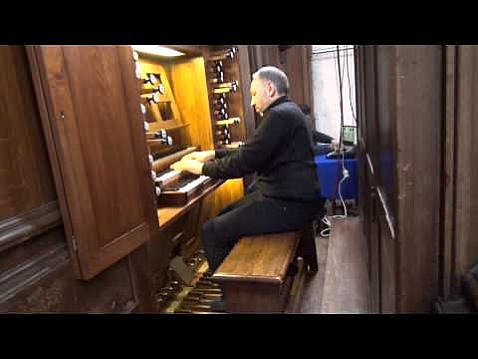



ORGANS OF PARIS © 2024 Vincent Hildebrandt HOME ALL ORGANS



The ‘traditional’ and the ‘augmented’ organ
The organ of Suret is an organ with on one side many
characteristics of the past centuries (reeds, cornet,
plein jeu) and on the other side many innovations
charateristic of the first half of the 19th century (with
the exception of Barker machines, which were never
installed). This 'traditional' organ is demonstrated by
Christophe d'Alessandro, organiste titulaire de la Ste
Elisabeth, in works by Louis Couperin (1626-1661),
Auguste Bazille (1828-1891, first Titulaire of Sainte
Élisabeth) and Félix Foudrain (1880-1923, former
titulaire of Sainte Élisabeth).
The organ of Ste Elisabeth is equipped with
microphones inside the five works of the organ and
loudspeakers behind the organ to enable a mix of the
traditional organ sound with live electronical sounds.
New technologies of processing audio and Vidéo real
time are thus used to increase/modify the sound of an
organ. The sound of the organ is captured, modified,
and distributed in space in real time. The real and the
virtual are mixed in the acoustic space of the church.
The augmented organ is played by the organist
(Christophe d’Alessandro, the organist titulaire of Ste
Elisabeth) and by the musician that controls real-time
processing and dissemination of the sound of the
instrument (Markus Noissternig, computer music
composer and electrical and audio engineer). This
‘augmented’ organ is demonstrated by three
improvisations.
Explanation of the augmented organ
Explication de l’orgue augmentée
Erklärung über die Klanginstallation

F3
The organ of Sainte Élisabeth is built by Antoine Suret in
1852-1853 and was showed on the word exhibition of 1855
as an example of fine Parisian organ building. It won a first
price, as is indicated on the organ case, which itself is very
impressive. It is one of the few organs of this builder still
present in Paris. The organ is charateristic for this (pre-
romantic) period, with many reed stops (16 on 39), of which
three are free: Euphone, Cor Anglais and the (nowadays
missing) Hautbois of the Swell. It also houses a new stop:
the Kéraulophone, invented by Gray & Davison (London,
1843).
The organ was profoundly modified by G. Gutschenritter at
the beginning of the twentieth century (towards a more
symphonic style) and in 1941-1955 (towards a more
neoclassical style with change of traction, which became
pneumatic).
Overhaulded in 1976 by Philippe Hartmann, the positive
was restored in 1985 by Théo Haerpfer.
It was restored towards the creation of Suret in 1994-1999
by Giroud.
Brochure
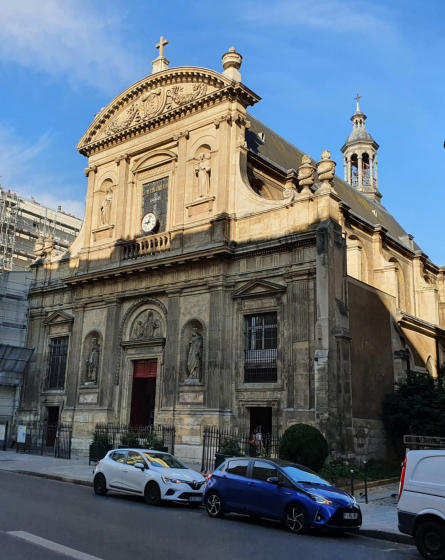
This former Franciscan convent chapel was dedicated
to Saint Elizabeth of Hungary in 1646. It was
constructed by architect Paul de Gonde. Its classic
facade has both Doric and Ionic elements. During the
reconstruction of the City under Napoleon III, the
church lost its Chapel of the Virgin to make room for
the Rue Turbigo. In the choir is a panel of Flemish wood
sculptures from the beginning of the 17th century,
coming from the former abbey of Saint-Vaast d'Arras.
Organiste titulaire
Christophe d'Alessandro
Concerts
Irregularly
Masses with organ
Saturday 6.30PM, Sunday 11AM
Video
Christophe d'Alessandro
Photos: Jeroen de Haan
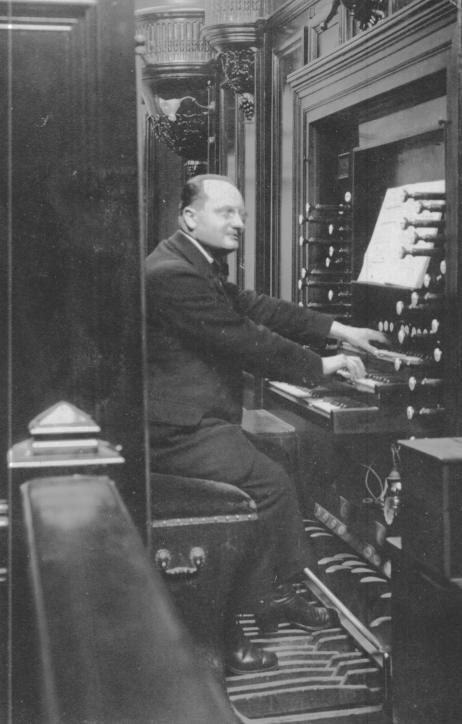
The old console
(Facebook Xavier Lebrun)
Organiste : possibly Felix Fourdrain
1853 - Suret (1)
19xx/41/55 - Gutschenritter (3a)
1976 - Philippe Hartman (6)
1985 - Haerpfer (6)
1994-99 - Michel Giroud (4)
III/39 - traction mécanique
composition
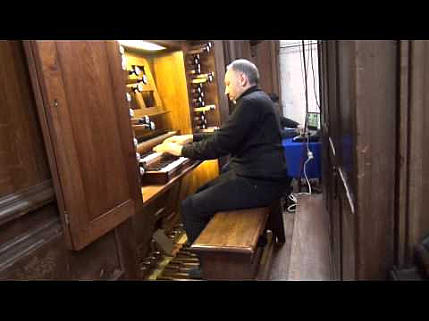
The organs of Paris
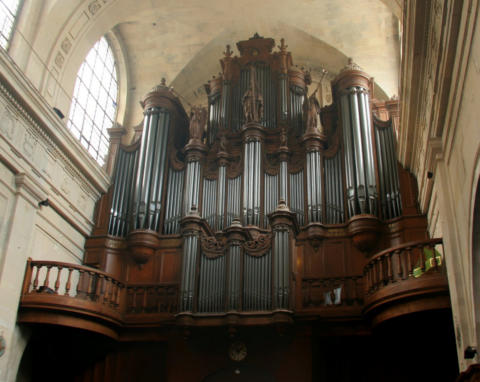
ORGANS OF PARIS © 2024 Vincent Hildebrandt ALL ORGANS
F3
The organ of Sainte Élisabeth is built by Antoine Suret in
1852-1853 and was showed on the word exhibition of 1855
as an example of fine Parisian organ building. It won a first
price, as is indicated on the organ case, which itself is very
impressive. It is one of the few organs of this builder still
present in Paris. The organ is charateristic for this (pre-
romantic) period, with many reed stops (16 on 39), of which
three are free: Euphone, Cor Anglais and the (nowadays
missing) Hautbois of the Swell. It also houses a new stop:
the Kéraulophone, invented by Gray & Davison (London,
1843).
The organ was profoundly modified by G. Gutschenritter at
the beginning of the twentieth century (towards a more
symphonic style) and in 1941-1955 (towards a more
neoclassical style with change of traction, which became
pneumatic).
Overhaulded in 1976 by Philippe Hartmann, the positive
was restored in 1985 by Théo Haerpfer.
It was restored towards the creation of Suret in 1994-1999
by Giroud.
Brochure
Organiste titulaire
Christophe d'Alessandro
Concerts
Irregularly
Masses with organ
Saturday 6.30PM, Sunday 11AM
Video
Christophe d'Alessandro
Photos: Jeroen de Haan
The ‘traditional’ and the ‘augmented’ organ
The organ of Suret is an organ with on one side many
characteristics of the past centuries (reeds, cornet, plein jeu)
and on the other side many innovations charateristic of the
first half of the 19th century (with the exception of Barker
machines, which were never installed). This 'traditional' organ
is demonstrated by Christophe d'Alessandro, organiste
titulaire de la Ste Elisabeth, in works by Louis Couperin (1626-
1661), Auguste Bazille (1828-1891, first Titulaire of Sainte
Élisabeth) and Félix Foudrain (1880-1923, former titulaire of
Sainte Élisabeth).
The organ of Ste Elisabeth is equipped with microphones
inside the five works of the organ and loudspeakers behind
the organ to enable a mix of the traditional organ sound with
live electronical sounds. New technologies of processing
audio and Vidéo real time are thus used to increase/modify
the sound of an organ. The sound of the organ is captured,
modified, and distributed in space in real time. The real and
the virtual are mixed in the acoustic space of the church. The
augmented organ is played by the organist (Christophe
d’Alessandro, the organist titulaire of Ste Elisabeth) and by the
musician that controls real-time processing and
dissemination of the sound of the instrument (Markus
Noissternig, computer music composer and electrical and
audio engineer). This ‘augmented’ organ is demonstrated by
three improvisations.
Explanation of the augmented organ
Explication de l’orgue augmentée
Erklärung über die Klanginstallation
1853 - Suret (1)
19xx/41/55 - Gutschenritter (3a)
1976 - Philippe Hartman (6)
1985 - Haerpfer (6)
1994-99 - Michel Giroud (4)
III/39 - traction mécanique
composition
